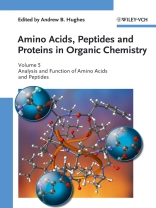This is the last of five books in the Amino Acids, Peptides and Proteins in Organic Synthesis series.
Closing a gap in the literature, this is the only series to cover this important topic in organic and biochemistry. Drawing upon the combined expertise of the international ‘who`s who’ in amino acid research, these volumes represent a real benchmark for amino acid chemistry, providing a comprehensive discussion of the occurrence, uses and applications of amino acids and, by extension, their polymeric forms, peptides and proteins. The practical value of each volume is heightened by the inclusion of experimental procedures.
Volume 5 of this five-volume series presents a wealth of methods to analyze amino acids and peptides. Classical approaches are described, such as X-ray analysis, chromatographic methods, NMR, AFM, mass spectrometry and 2D-gel electrophoresis, as well as newer approaches, including Surface Plasmon Resonance and array technologies.
This volume also elucidates the function of selected amino acids and peptides in more detail. Specifi c examples include the role of N-methylated peptides and the function of cysteine .
Closing a gap in the literature, this is the only series to cover this important topic in organic and biochemistry. Drawing upon the combined expertise of the international ‘who`s who’ in amino acid research, these volumes represent a real benchmark for amino acid chemistry, providing a comprehensive discussion of the occurrence, uses and applications of amino acids and, by extension, their polymeric forms, peptides and proteins. The practical value of each volume is heightened by the inclusion of experimental procedures.
Volume 5 of this five-volume series presents a wealth of methods to analyze amino acids and peptides. Classical approaches are described, such as X-ray analysis, chromatographic methods, NMR, AFM, mass spectrometry and 2D-gel electrophoresis, as well as newer approaches, including Surface Plasmon Resonance and array technologies.
This volume also elucidates the function of selected amino acids and peptides in more detail. Specifi c examples include the role of N-methylated peptides and the function of cysteine .
Table of Content
MASS SPECTROMETRY OF AMINO ACIDS AND PROTEINSIntroduction
Basic Protein Chemistry and How it Relates to MS
Sample Preparation and Data Acquisition
Data Analysis of LC-MS/MS (or CE-MS/MS) of Mixtures
MS of Protein Structure, Folding, and Interactions
Conclusions and Perspectives
X-RAY STRUCTURE DETERMINATION OF PROTEINS AND PEPTIDES
Introduction
Growing Crystals
Symmetry and Space Groups
X-Ray Scattering and Diffraction
Collecting and Processing Diffraction Data
Solving the Structure (Determining Phases)
Analyzing and Refining the Structure
NUCLEAR MAGNETIC RESONANCE OF AMINO ACIDS, PEPTIDES, AND PROTEINS
Introduction
Amino Acids
Peptides
Proteins
Conclusions
STRUCTURE AND ACTIVITY OF N-METHYLATED PEPTIDES
Introduction
Conformational Effects of N-Methylation
Effects of N-Methylation on Bioactive Peptides
Concluding Remarks
HIGH-PERFORMANCE LIQUID CHROMATOGRAPHY OF PEPTIDES AND PROTEINS
Introduction
Basic Terms and Concepts in Chromatography
Chemical Structure of Peptides and Proteins
HPLC Separation Modes in Peptide and Protein Analysis
Method Development from Analytical to Preparative Scale Illustrated for HP-RPC
Multidimensional HPLC
Conclusions
LOCAL SURFACE PLASMON RESONANCE AND ELECTROCHEMICAL BIOSENSING SYSTEMS FOR ANALYZING FUNCTIONAL PEPTIDES
Localized Surface Plasmon Resonance (LSPR)-Based Microfluidics Biosensor for the Detection of Insulin Peptide Hormone
Electrochemical LSPR-Based Label-Free Detection of Melittin
Label-Free Electrochemical Monitoring of Beta-Amyloid (ABeta) Peptide Aggragation
SURFACE PLASMON RESONANCE SPECTROSCOPY IN THE BIOSCIENCES
Introduction
SPR-Based Optical Biosensors
Principle of Operation of SPR Biosensors
Description of a SPR Instrument
Application of SPR in Immunosensor Design
Application of SPR in Membrane Interactions
Data Analysis
Conclusions
ATOMIC FORCE MICROSCOPY OF PROTEINS
Foreword
AFM
Bioimaging Highlights
Issues
Force Measurements
Liquid Imaging
Sample Preparation for Bioimaging
Outlook
SOLVENT INTERACTIONS WITH PROTEINS AND OTHER MACROMOLECULES
Introduction
Solvent Applications
Solvent Application for Viruses
Solvent Application for DNA
Mechanism
Protein-Solvent Interactions in Frozen and Freeze-Dried Systems
Conclusions
ROLE OF CYSTEINE
Sulfur: A Redox Chameleon with Many Faces
Three Faces of Thiols: Nucleophilicity, Redox Activity, and Metal Binding
Towards a Dynamic Picture of Disulfide Bonds
Chemical Protection and Regulation via S-Thiolation
‘Dormant’ Catalytic Sites
Peroxiredoxiin/Sulfiredoxin Catalysis and Control Pathway
Higher Sulfur Oxidation States: From the Shadows to the Heart of Biological Sulfur Chemistry
Cysteine as a Target for Oxidants, Metal Ions, and Drug Molecules
Conclusions and Outlook
ROLE OF DISULFIDE BONDS IN PEPTIDE AND PROTEIN CONFORMATION
Introduction
Probing the Role of Disulfide Bonds
Contribution of Disulfide Bonds to Protein Stability
Role of Disulfide Bonds in Protein Folding
Role of Individual Disulfide Bonds in Protein Structure
Disulfide Bonds in Protein Dynamics
Disulfide Bonding Patterns and Protein Topology
Applications
Conclusions
QUANTITATIVE MASS SPECTROMETRY-BASED PROTEOMICS
Introduction
Quantification in Biological MS
Indentifying Proteins Interacting with Small Molecules with Quantitative Proteomics
Conclusions
TWO-DIMENSIONAL GEL ELECTROPHORESIS AND PROTEIN/POLYPEPTIDE ASSIGNMENT
Introduction
Aim of Protein Analysis and Development of 2-DE Techniques
Current Status of 2-DE Techniques
Development of Protein Assignment Techniques on 2-DE Gels and Current Status of Mass Spectrometric Techniques
Conclusions
BIOINFORMATICS TOOLS FOR DETECTING POST-TRANSLATIONAL MODIFICATIONS IN MASS SPECTROMETRY DATA
Introduction
PTM Discovery with MS
Database Resources for PTM Analysis
Conclusions
About the author
Andrew Hughes is a reader and associate professor of chemistry at La Trobe University, Melbourne, Australia. He obtained his degrees from the University of Western Australia, before taking up post-doctoral appointments at the University of Cambridge starting in 1989. After threeyears working with Professor Andrew Holmes, he joined Professor Steven Ley`s group. While at Cambridge he was appointed the Shell Research Fellow at Robinson College. His interests lie in the general fi eld of asymmetric synthesis and methodology, with a recent focus on amino acid chemistry and diffi cult peptides.
Language English ● Format PDF ● Pages 490 ● ISBN 9783527631858 ● File size 10.1 MB ● Publisher Wiley-VCH ● Published 2013 ● Edition 1 ● Downloadable 24 months ● Currency EUR ● ID 2658923 ● Copy protection Adobe DRM
Requires a DRM capable ebook reader












